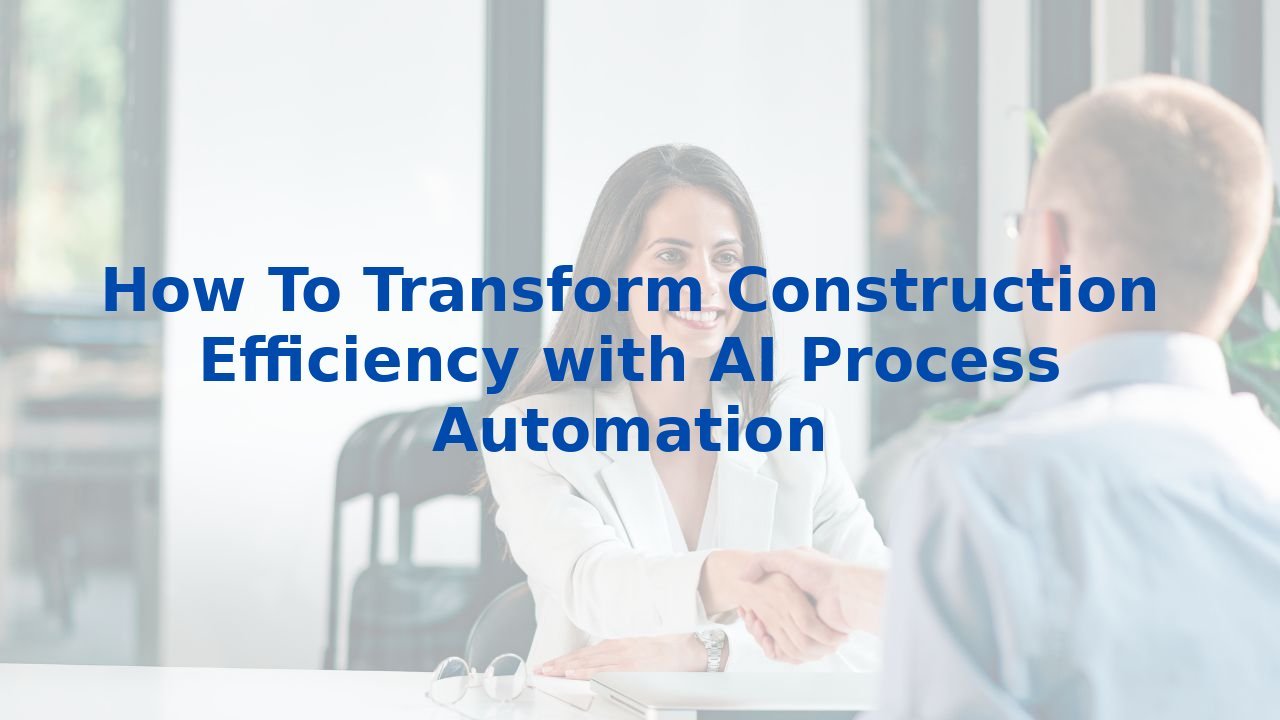How To Transform Construction Efficiency with AI Process Automation
Unlock Process Automation Inspiration: Transforming Construction with AI
In the dynamic world of construction, the path to efficiency and excellence has been significantly reshaped by the integration of artificial intelligence (AI) and digital process automation. Companies are rapidly realizing the immense potential of AI to streamline operations, enhance productivity, and unlock new avenues of innovation. One standout example of this transformative journey can be seen through the inspiring case of a certain construction giant, which has embraced the power of automation to revolutionize its business processes.
The Digital Leap: Initial Success Sparks Transformation
The construction powerhouse initiated its digitization journey with a single automated process, laying the foundation for an expansive wave of transformation. This initial leap into automation showcased not only the potential for increased efficiency but also the company's commitment to health and safety within the workplace. Over time, the successful implementation fueled a remarkable expansion, culminating in the launch of over 50 automated processes across various functions.
This pivotal decision illustrates a vital lesson for organizations across any industry: the first step toward automation—no matter how small—can generate significant momentum. Perhaps more importantly, each automated process introduces newfound clarity and precision into operations, ultimately increasing responsiveness to changing market demands.
Identifying Key Business Processes for Improvement
Successful automation requires identifying business processes ripe for enhancement. In construction, numerous functions can benefit from AI, such as:
- Project Management: AI can assist in predictive analytics, enabling teams to make data-driven decisions and improve project timelines.
- Resource Allocation: Automating resource management can optimize the use of materials and manpower, significantly reducing waste.
- Risk Assessment: By analyzing a variety of data inputs, AI can identify potential risks associated with safety and engineering challenges, allowing for proactive measures.
- Supply Chain Management: Enhanced visibility through AI-powered tools can streamline procurement and logistics, decreasing delays and ensuring projects stay on schedule.
The ripple effect of automating these processes ultimately leads to enhanced productivity and increased operational efficiency, allowing organizations to allocate time and resources toward critical growth initiatives.
AI Driving Efficiency: The Amplifying Benefits
Integrating AI into business operations not only optimizes existing processes but also introduces a new paradigm of efficiency. By harnessing AI’s capabilities, organizations can:
- Enhance Accuracy: Automation minimizes the chance of human error, leading to more accurate data and insights that drive sound decision-making.
- Increase Speed: Processes that once took hours or days can be completed in a fraction of the time, accelerating project timelines and responsiveness.
- Improve Collaboration: Enhanced data sharing and communication tools foster a more collaborative environment, ensuring all team members are aligned and informed.
- Boost Compliance: AI can help ensure regulatory compliance by managing and auditing processes systematically.
Embracing such advancements allows organizations to redefine their operational playbook, positioning them as forward-thinking leaders in their industries.
Empowering Employees through AI Training
As organizations integrate AI into their workflows, a critical component of success lies in equipping employees with the necessary skills. Investing in employee training that focuses on AI tools and applications enhances workforce readiness and closes skills gaps. Training can include:
- Understanding AI Principles: Fundamental knowledge of how AI functions empowers employees to utilize AI-driven tools effectively.
- Hands-On Experience: Practical training allows employees to gain direct experience with AI tools, fostering confidence and capability.
- Adaptation to New Processes: As new automated processes roll out, training supports a smooth transition, ensuring employees are comfortable with changes.
Overall, a well-trained workforce is crucial in maximizing the benefits of AI integration. When employees understand the tools at their disposal, organizations can achieve enhanced collaboration, increased productivity, and a healthy culture of innovation.
Conclusion: The Future is Bright with AI
The initial steps taken by this construction leader have ignited a digital revolution, showcasing the power of process automation. As each automated function further refines business operations, the potential for growth and efficiency becomes limitless. By embracing AI-driven processes and investing in employee training, organizations are poised to thrive in a competitive landscape, leading the charge towards a bright future in the construction sector and beyond.
Integrating AI is more than just adopting new technology; it’s about fostering a culture of innovation and growth.



